The Samsung Galaxy S6 and S6 edge Review
by Joshua Ho on April 17, 2015 9:00 AM EST- Posted in
- Smartphones
- Samsung
- Mobile
- Galaxy S6
- Galaxy S6 Edge
NAND Performance: The First UFS Phone
Storage performance is often a critical area for user performance, as applications cannot be cached in RAM at every possible moment. Camera performance is also often limited by storage performance as RAM buffers can only do so much to maintain performance before it’s necessary to commit photos to non-volatile storage.
However due to the memory hierarchy to some extent, storage performance is often hard to notice once it’s at a point where things are “good enough”. Unfortunately, in some cases we can see OEMs failing to include sufficiently performant solid-state storage, which can be a major pain point in the user experience when random read/write performance is low enough that there are noticeable IO pauses as the system has to wait for data to be loaded from storage.
The Samsung Galaxy S6 family is the first shipping implementation of UFS (Universal Flash Storage) 2.0 standard, which makes the internal storage model less like an SD card in nature. When comparing the eMMC 5.1 standard to the UFS 2.0 standard, we see a move from a the 400 MB/s maximum of the eMMC 5.1 standard with HS400 physical link interface to MIPI M-PHY, which allows for a theoretical maximum of around 720 MB/s and should be more efficient in transmitting data than the current eMMC standard. In addition, UFS makes it possible to do full duplex communication, which means that reads and writes can happen simultaneously. There's also a command queue, which helps to avoid inefficiencies that could arise from waiting for commands once a command has been processed by the storage controller, and utilizes the SCSI protocol to facilitate these new features at the interface level.
As for the Galaxy S6 itself, the UFS implementation Samsung is using is Samsung developed. Samsung's current implementation only supports up to 300 MB/s (or 2.4 Gbps) transfer rates as a theoretical maximum, so from an interface perspective it's still not reaching the full capabilities of the standard. Though even at a cap of 300MB/sec, it still stands to be a significant improvement over typical eMMC solutions.
Finally, on a technical note, the 32GB models are of the model KLUBG4G1BD-E0B1 with a maximum queue depth of 16.
In order to test storage performance, we use Androbench with some custom settings to get a reasonable idea of performance in this area, although this test isn’t an exhaustive examination of storage performance by any means.
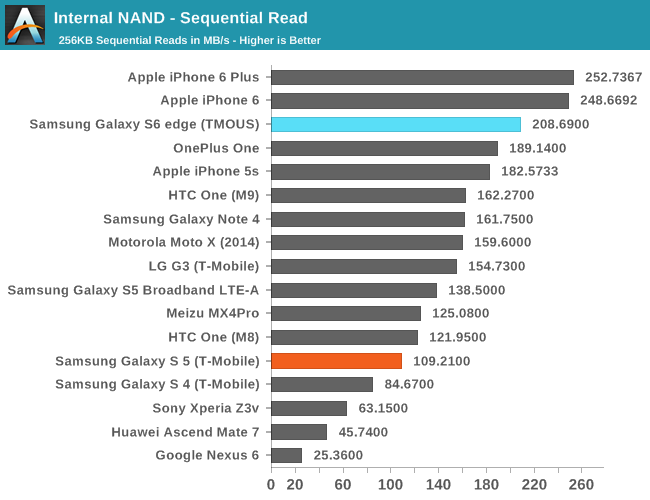
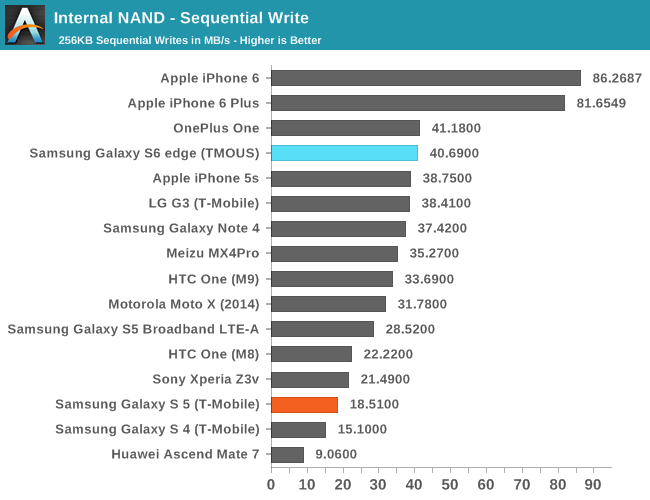
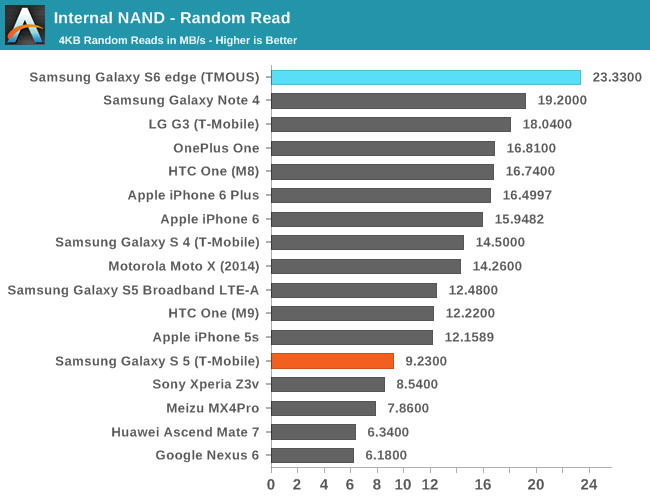
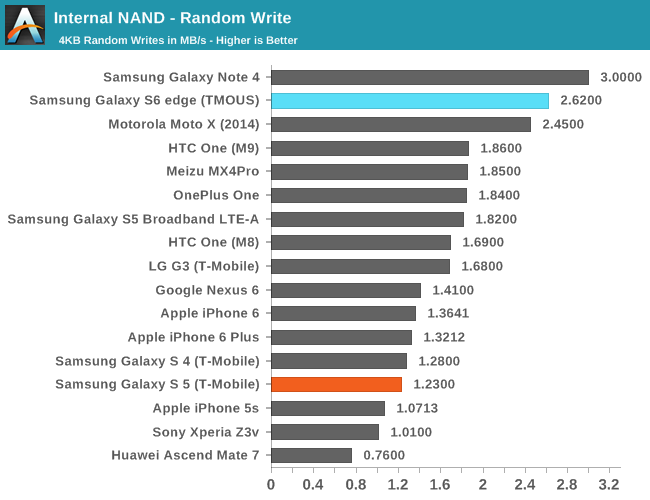
The Galaxy S6 performs rather impressively in our standard storage test, but not as fast as one might have hoped. This is due to the nature of the Androbench 3.6 test, which only tests a single IO thread, which won’t use the UFS storage of the Galaxy S6 to its full extent. In order to see the kind of difference that UFS really makes, I ran the same test again on Androbench 4.x, which does support multiple IO threads. However, as our iOS storage test and Androbench 3.6 don’t support more than a single IO thread we will continue to present both results for now.
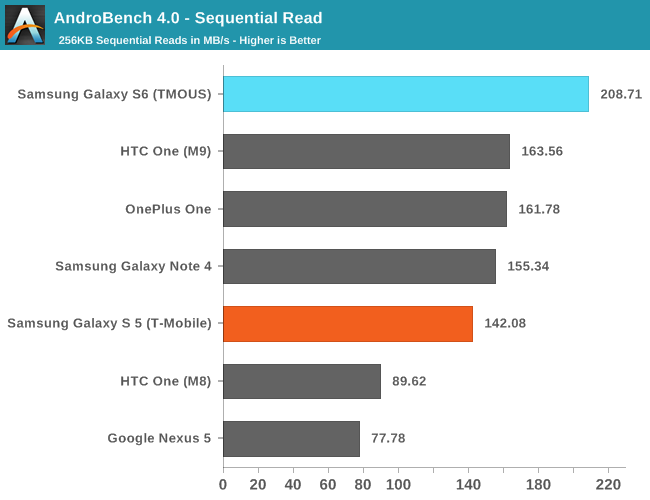
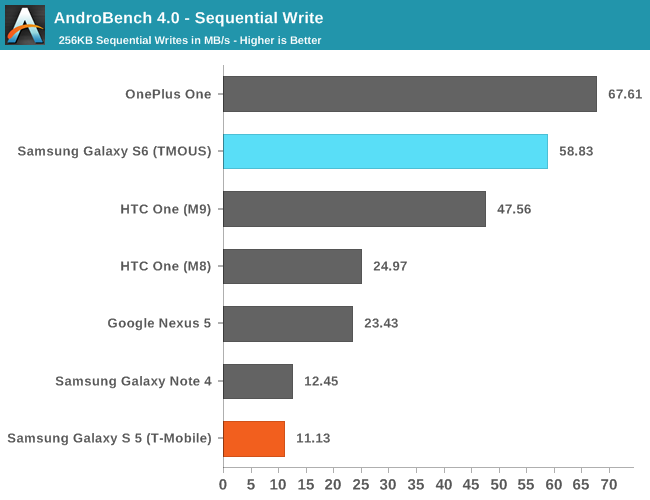
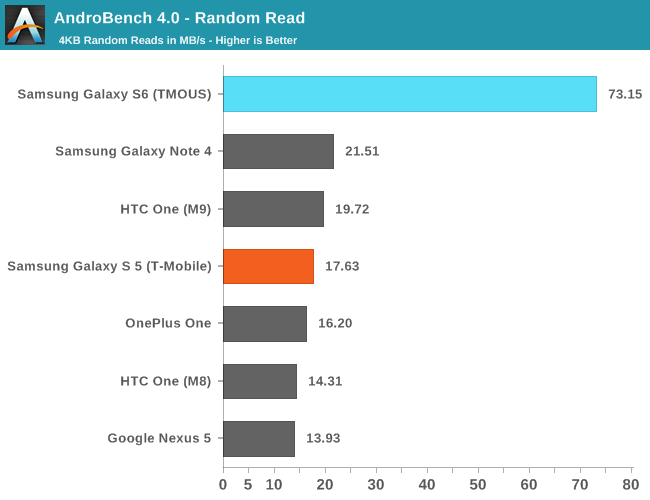
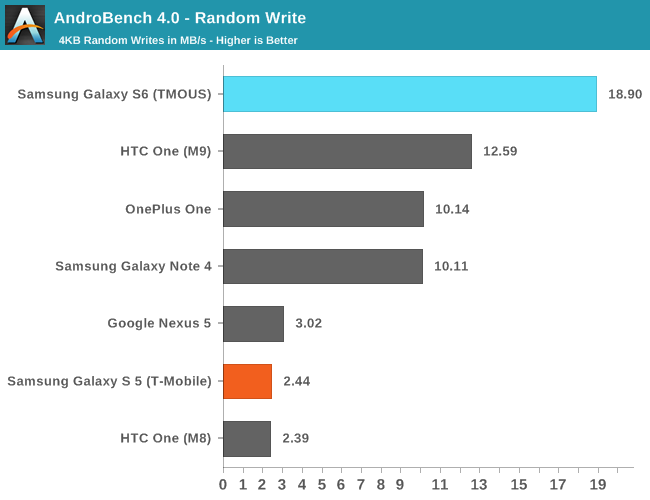
Overall, there are some immense benefits in storage performance here, especially in random IO performance. The Galaxy S6 has some of the fastest storage available in a phone today as far as I can tell given that this is basically a pure MLC solution, and shouldn’t have any real issue with storage performance holding back the rest of the phone over the course of 1-3 years as long as a reasonable amount of free space is kept to allow efficient storage management.


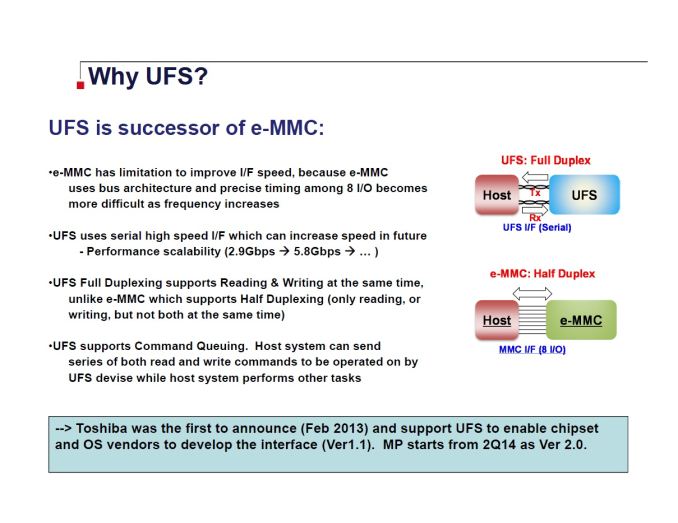








306 Comments
View All Comments
ianmills - Friday, April 17, 2015 - link
So having an sd card in metal body is impossible then?will54 - Monday, April 20, 2015 - link
Not sure if you are serious or joking since sarcasm is so hard to catch on the net, but my One M8 has an sd slot nevermind that most if not all phones have a sim slot .juxt417 - Wednesday, April 22, 2015 - link
No but an SD card loading 4k pictures and video without lag is.akdj - Sunday, May 31, 2015 - link
Someone should let Nikon, Canon, Sony ...even RED uses CF cards -- I believe? Silly jux, you can very easily capture these bitrates to any class ten MicroSD card. I was capturing 4k on my Note 3 a year ago on a card half the speed of the one in my Note 4.FlushedBubblyJock - Friday, April 24, 2015 - link
that's the insane claim - the metal body precludes the sd card - just bow your head, scramble your brains for them, pretend you're stupid as a rock, and stfu, please, the overlords desire that their lies be swallowed and enjoyed, preferably on your knees in full worshipful regale, knave, believe, you want to believe don't you ?akdj - Sunday, May 31, 2015 - link
What the hell is a smartphone 'power user'? Are you one of the dbags I see walking around, texting and not paying attention to society or your surrounding?Surious, I'm curious what it is that makes YOU a power user of ...a smartphone?
(To lay it out there, I own a phone with MicroSD/battery replaceability as well as one without and I can honestly say the ability to use my mSD card with each iteration of Android has diminished significantly ...and having to 'split' apps between system and external storage makes for a HIGE PITA when it comes to backing up a phone with or without and then restoring a new Android model, again ...with or without ...maybe I'm a 'power user' and wasn't aware)
Genuine and honest curiousity from a fellow SD user --- & current Note 4 & S6 owner for nearly a month now ---
Fallen Kell - Friday, April 17, 2015 - link
Samsung lost my sale. I had been holding off until the S6 came out, but no SD card slot = no purchase from me. Now I am looking for another phone, and in the meantime keeping the one I have until I get a high end phone with SD card slot (possibly HTC releases the E9+ in NA with all the complaints they have had for not doing so, and especially given the fact that Samsung has obviously dropped the ball on the S6 opening the door for a high end HTC that has all the bells and whistles to take over the market).JeffFlanagan - Friday, April 17, 2015 - link
They'll lose a few customers, but I was willing to give up the SD slot. The S6 is beautiful, and much more responsive than the HTC One (M8) that I traded in. LTE reception is also much better, so I can stream video and music, so 64GB is plenty of storage.bogda - Friday, April 17, 2015 - link
Do you know that 32GB MicroSD costs 13$ on Amazon? And you are willing to pay 100$ for upgrade from 32 to 64? Funny.name99 - Friday, April 17, 2015 - link
And that 32GB SD card performs at the level of the flash that we have in this phone?No?
So then why is its price relevant?